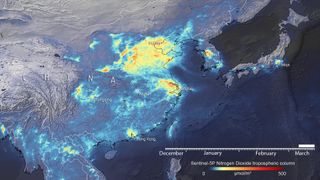Satellite track emissions drop over China, Italy during coronavirus outbreak
As the coronavirus pandemic continues to spread around the globe, more and more regulations surrounding work and travel have been put in place to reduce the risk of transmission. As satellites orbiting Earth have observed, this has resulted in lowered air pollution over Italy and lowered nitrogen-dioxide emissions over China.
When the coronavirus first appeared, in December 2019 in the Hubei Province in China, factories closed and people quarantined and ceased their daily activities. So, shopping, regular work schedules and more quickly phased out of everyday life. As the outbreak grew in Italy, the same measures were taken.
TROPOMI, the Tropospheric Monitoring Instrument onboard the Copernicus satellite — which is a collaboration among the European Space Agency, the European Commission, the Netherlands Space Office, industry, data users and scientists — has been observing these atmospheric changes from space.
Related: The coronavirus pandemic and space exploration: Full coverage
More: Free space projects for kids at home due to coronavirus outbreak

The Copernicus Atmosphere Monitoring Service (CAMS) has been, with this instrument, identifying a significant drop in fine particulate matter (a major air pollutant). With both satellite observations and computer models of the atmosphere, researchers have found a 20%-30% decrease in surface particulate matter over huge swaths of China.
The animation (above) shows, with data from Copernicus, how nitrogen dioxide emissions have dropped from Dec. 20, 2019, to March 16, 2020 (with a 10-day moving average). Toward the end of March, you can see the emissions increase again, but there is a distinct and significant drop in late January.
"Satellites offer a unique vantage point to monitor the health of our planet. Sentinel-5P is one of seven Copernicus satellites in orbit today. It currently provides the most accurate measurements of nitrogen dioxide and other trace gases from space," Josef Aschbacher, ESA's director of Earth observation programs, said in a statement.
Get the Space.com Newsletter
Breaking space news, the latest updates on rocket launches, skywatching events and more!
"As nitrogen dioxide is primarily produced by traffic and factories, it is a first-level indicator of industrial activity worldwide. What is clearly visible is a significant reduction of nitrogen dioxide levels over China, caused by reduced activity due to COVID-19 restrictions, but also the Chinese New Year in January.”
Still, these are just rough estimates, Claus Zehner, ESA's Copernicus Sentinel-5P mission manager, added in the statement. "We are conducting a detailed scientific analysis which will soon provide more insights and quantified results in the following weeks and months," Zehner said.
- Dramatic effect of coronavirus lockdowns seen from space
- NASA center in California issues mandatory work-from-home order
- Space Symposium 2020 postponed indefinitely due to coronavirus pandemic
Follow Chelsea Gohd on Twitter @chelsea_gohd. Follow us on Twitter @Spacedotcom and on Facebook.
OFFER: Save at least 56% with our latest magazine deal!
All About Space magazine takes you on an awe-inspiring journey through our solar system and beyond, from the amazing technology and spacecraft that enables humanity to venture into orbit, to the complexities of space science.
Join our Space Forums to keep talking space on the latest missions, night sky and more! And if you have a news tip, correction or comment, let us know at: community@space.com.

Chelsea “Foxanne” Gohd joined Space.com in 2018 and is now a Senior Writer, writing about everything from climate change to planetary science and human spaceflight in both articles and on-camera in videos. With a degree in Public Health and biological sciences, Chelsea has written and worked for institutions including the American Museum of Natural History, Scientific American, Discover Magazine Blog, Astronomy Magazine and Live Science. When not writing, editing or filming something space-y, Chelsea "Foxanne" Gohd is writing music and performing as Foxanne, even launching a song to space in 2021 with Inspiration4. You can follow her on Twitter @chelsea_gohd and @foxannemusic.
